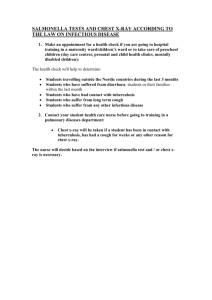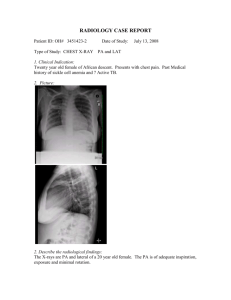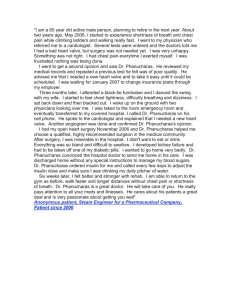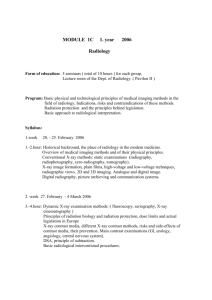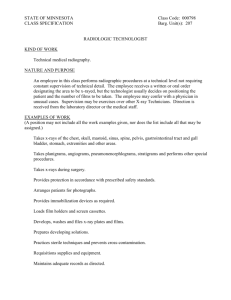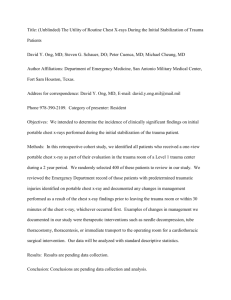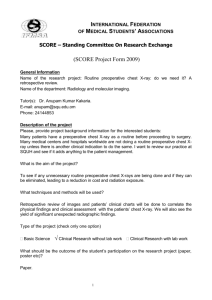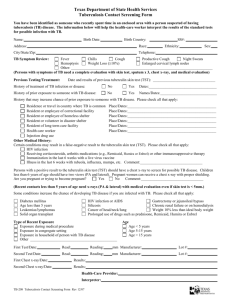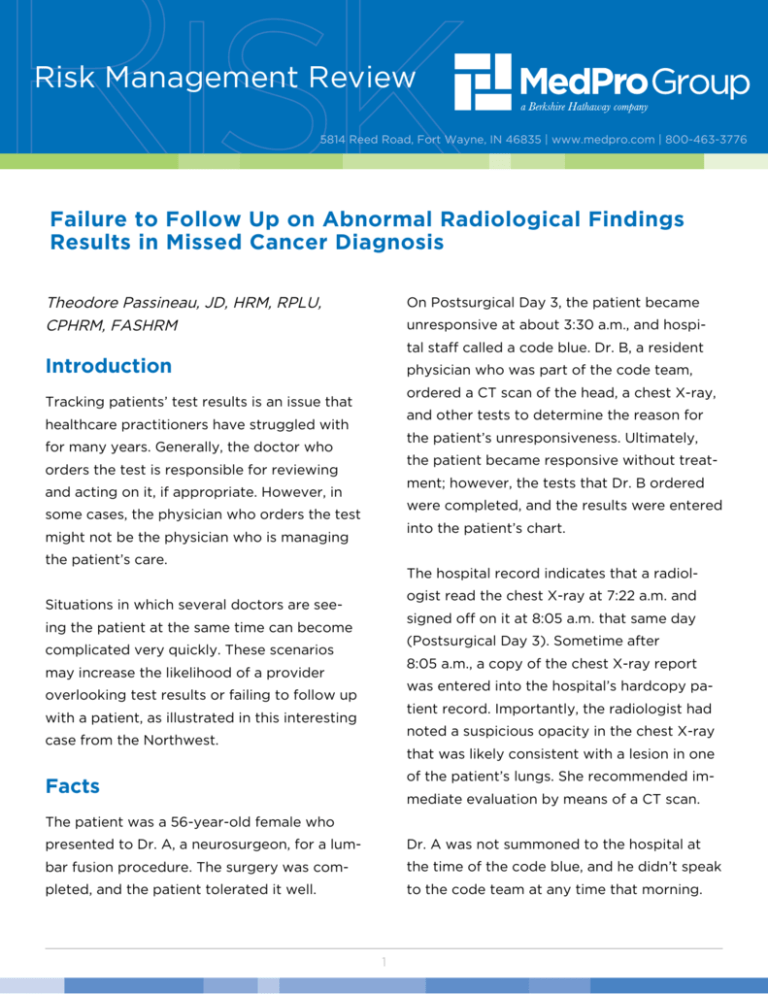
Risk Management Review
5814 Reed Road, Fort Wayne, IN 46835 | www.medpro.com | 800-463-3776
Failure to Follow Up on Abnormal Radiological Findings
Results in Missed Cancer Diagnosis
Theodore Passineau, JD, HRM, RPLU,
CPHRM, FASHRM
On Postsurgical Day 3, the patient became
unresponsive at about 3:30 a.m., and hospital staff called a code blue. Dr. B, a resident
Introduction
physician who was part of the code team,
ordered a CT scan of the head, a chest X-ray,
Tracking patients’ test results is an issue that
and other tests to determine the reason for
healthcare practitioners have struggled with
the patient’s unresponsiveness. Ultimately,
for many years. Generally, the doctor who
the patient became responsive without treat-
orders the test is responsible for reviewing
ment; however, the tests that Dr. B ordered
and acting on it, if appropriate. However, in
were completed, and the results were entered
some cases, the physician who orders the test
into the patient’s chart.
might not be the physician who is managing
the patient’s care.
The hospital record indicates that a radiologist read the chest X-ray at 7:22 a.m. and
Situations in which several doctors are see-
signed off on it at 8:05 a.m. that same day
ing the patient at the same time can become
(Postsurgical Day 3). Sometime after
complicated very quickly. These scenarios
8:05 a.m., a copy of the chest X-ray report
may increase the likelihood of a provider
was entered into the hospital’s hardcopy pa-
overlooking test results or failing to follow up
tient record. Importantly, the radiologist had
with a patient, as illustrated in this interesting
noted a suspicious opacity in the chest X-ray
case from the Northwest.
that was likely consistent with a lesion in one
of the patient’s lungs. She recommended im-
Facts
mediate evaluation by means of a CT scan.
The patient was a 56-year-old female who
presented to Dr. A, a neurosurgeon, for a lum-
Dr. A was not summoned to the hospital at
bar fusion procedure. The surgery was com-
the time of the code blue, and he didn’t speak
pleted, and the patient tolerated it well.
to the code team at any time that morning.
1
By the time he became aware of the code
metastases to the brain. She died approxi-
blue, the patient was stable. Further, his con-
mately 6 months after that (about 18 months
tact with the patient that day occurred prior
after the original radiology report).
to 8:00 a.m., so he did not see the radiology
report that morning. Additionally, there is no
A medical malpractice lawsuit was com-
indication that Dr. B ever reviewed the radiol-
menced against Dr. A and the hospital (as
ogy report. He apparently ordered it in Dr. A’s
the employer of Dr. B). The radiologist and
name (because Dr. A was the attending phy-
cardiologist were not sued. At the request of
sician) and assumed Dr. A would review it.
Dr. A, the case against him was settled with
a payment in the low end of the midrange,
That same morning, consistent with hospi-
with defense costs in the high range. Be-
tal protocol, the radiology report was faxed
cause MedPro did not insure the hospital, the
to Dr. A’s multi-neurosurgeon practice. The
amount of payment made on Dr. B’s behalf is
report was filed in the patient’s chart at the
not known.
practice without any healthcare practitioner
Discussion
reviewing it. Dr. A later explained that all test
results for his patients are put into his inbox
Depending on individual point of view, Dr. A
for review, with the exception of (a) tests he
can be viewed either as a victim of circum-
has not personally ordered, or (b) plain X-ray
stances or as a clinician who simply did not
results. Although Dr. A did not order the
do what he should have done. Although it
chest X-ray, it was reported back to the prac-
probably was not necessary for hospital staff
tice in his name because of how Dr. B ordered
to summon Dr. A to the hospital at the time
it. Yet, because the test was a plain X-ray, the
of the code blue, it certainly would have been
results were filed without review.
appropriate to notify him sometime early that
morning of the patient’s unresponsiveness.
Two days after Dr. B ordered the chest X-ray
Nothing indicates that such notification took
(Postsurgical Day 5), the patient was seen
place. If Dr. A had been notified, it would
by a cardiologist. In his consult report, the
have been appropriate for him to speak to a
cardiologist briefly mentioned the abnormal
provider who participated in the code blue,
radiology report. He indicated that he would
preferably Dr. B.
leave it to the attending physician (Dr. A) to
follow up on that report. Unfortunately, when
Two important points in this case are related
Dr. A reviewed the cardiologist’s report, he
to the radiology report that was generated
missed the reference to the abnormal radiolo-
the morning of the code blue — the timing of
gy report. Thus, no follow-up with the patient
the report and the responsibility for reviewing
ever occurred.
the report. Dr. B did not consider the first risk
management rule for ordering tests — if you
Approximately 1 year later, the patient was
order the test, you are responsible for
diagnosed with stage IV lung cancer, with
2
reviewing the results and acting on them, if
The final issue in this case involves the cardi-
appropriate. Failure to do so was a misstep
ologist’s report, which was contained in the
on Dr. B’s part. Further, the system that al-
patient’s hospital record. From that report,
lowed Dr. B to order a test in the name of
it is clear that the cardiologist was aware
Dr. A is a systemic weakness that sets both
of the opacity on the chest X-ray. However,
doctors up for the exact type of failure that
he made only a fleeting reference to it in his
occurred in this case.
report, indicating that he would leave the task
of following up to Dr. A.
The radiology report was entered into the
hospital record after Dr. A reviewed the re-
A more prominent mention of the abnormal
cord on the morning of Postsurgical
finding in the cardiology report or a brief
Day 3. Thus, he did not see the report that
phone conversation (even by voicemail) be-
day. However, Dr. A dropped the ball by fail-
tween the cardiologist and Dr. A to discuss
ing to thoroughly review the hospital record
who was going to follow up would have been
the next time he was at the hospital. If he
ideal. However, the argument also can be
had, he would have seen the radiology report.
made that if Dr. A had thoroughly read the
Additionally, it would have been helpful if the
cardiologist’s report, he would have become
radiologist had placed a phone call to either
aware of the abnormal chest X-ray finding
Dr. A or Dr. B to advise them that her report
and taken action.
contained a potentially significant abnormal
Of note, even when communication and
finding.
responsibility for follow-up are not an issue,
Dr. A also was not helped by the fact that
it’s generally wise to make the patient and/
the radiology report was faxed to his office
or family aware of next steps and triggers
and filed in the patient’s record without any
for follow-up. Doing so enlists the patient as
healthcare practitioner reviewing the results.
another “fail safe” to prevent important infor-
Physicians are copied on many reports that
mation from falling through the cracks, which
they do not order, and they must determine
can occur as a result of poor communication
which of these reports they wish to review.
among providers.
However, a report ordered in the physician’s
name (as this report was) should never be
Despite the numerous missteps that occurred
filed without a competent reviewer reading
in the treatment of this patient and the unfor-
and signing off on it. In this case, the neuro-
tunate outcome, this case settled on behalf
surgical practice’s policy was to file plain films
of Dr. A for a very modest amount. This is
without any review. This policy produced a
because it was generally accepted that the
very high likelihood that, at some point, clini-
patient had advanced cancer at the time the
cally significant information would be missed.
chest X-ray was taken.
3
• Test results should never be filed in pa-
The consensus was that even if the cancer
had been diagnosed and treated sooner, the
tient records without review by appro-
care provided and the outcome would have
priate and competent healthcare
been substantially the same.
practitioners.
• Clinicians should never order testing in
Summary Suggestions
the name of another clinician.
• Consulting physicians should prominent-
The following suggestions may help clinicians
avoid or reduce communication lapses that
ly note significant incidental findings in
can result in missed or delayed diagnoses:
their reports to ensure that requesting
physicians will notice the information.
• The clinician who orders a test should
• When possible, clinicians should en-
have responsibility for reviewing the test
gage the patient and/or family in the
results and acting on those results, if
follow-up process as an additional “fail
appropriate.
safe” to ensure important information is
conveyed.
• Clinically significant events that occur in
hospitalized patients should be brought
Conclusion
to the attention of the attending physician as soon as possible.
With the increasing acuity of hospitalized pa-
• The more clinically significant test results
tients, the number of “moving parts” involved
are, the greater the need for the report-
in their care has never been greater. Each
ing physician to ensure that the appro-
additional process or step provides addition-
priate clinician is aware of the results in a
al opportunities for error. It is incumbent on
timely manner.
practitioners in all specialties and at all lev-
• In reviewing hospital records, clinicians
els to be vigilant in their communication and
should use care to ensure that they are
coordination of patient care. Further, systems
aware of all information entered in the
must be implemented that minimize the po-
record since their last review.
tential for human error to cause patient injury.
The information provided in this document should not be construed as medical or legal advice. Because the facts applicable to your
situation may vary, or the regulations applicable in your jurisdiction may be different, please contact your attorney or other professional advisors if you have any questions related to your legal or medical obligations or rights, state or federal statutes, contract
interpretation, or legal questions.
The Medical Protective Company and Princeton Insurance Company patient safety and risk consultants provide risk management
services on behalf of MedPro Group members, including The Medical Protective Company, Princeton Insurance Company, and
MedPro RRG Risk Retention Group.
©2015 MedPro Group.® All Rights Reserved.
4

